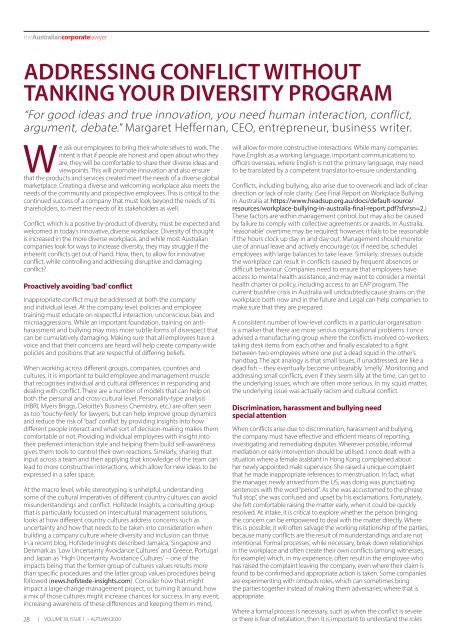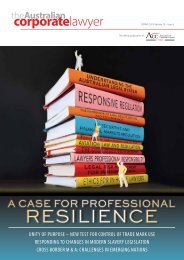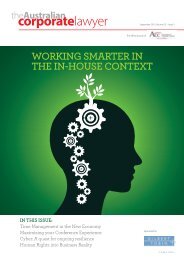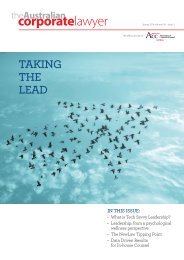Australian Corporate Lawyer - Autumn 2020
Australian Corporate Lawyer is the official publication of the Association of Corporate Counsel (ACC) Australia. The Autumn 2020 issue focuses on contract negotiation and features a range of articles covering topics including the importance of EQ for lawyers; managing employment rights in the social media age and addressing conflict in the workplace.
Australian Corporate Lawyer is the official publication of the Association of Corporate Counsel (ACC) Australia. The Autumn 2020 issue focuses on contract negotiation and features a range of articles covering topics including the importance of EQ for lawyers; managing employment rights in the social media age and addressing conflict in the workplace.
You also want an ePaper? Increase the reach of your titles
YUMPU automatically turns print PDFs into web optimized ePapers that Google loves.
the<strong>Australian</strong>corporatelawyer<br />
ADDRESSING CONFLICT WITHOUT<br />
TANKING YOUR DIVERSITY PROGRAM<br />
“For good ideas and true innovation, you need human interaction, conflict,<br />
argument, debate.” Margaret Heffernan, CEO, entrepreneur, business writer.<br />
We ask our employees to bring their whole selves to work. The<br />
intent is that if people are honest and open about who they<br />
are, they will be comfortable to share their diverse ideas and<br />
viewpoints. This will promote innovation and also ensure<br />
that the products and services created meet the needs of a diverse global<br />
marketplace. Creating a diverse and welcoming workplace also meets the<br />
needs of the community and prospective employees. This is critical to the<br />
continued success of a company that must look beyond the needs of its<br />
shareholders, to meet the needs of its stakeholders as well.<br />
Conflict, which is a positive by-product of diversity, must be expected and<br />
welcomed in today’s innovative, diverse workplace. Diversity of thought<br />
is increased in the more diverse workplace, and while most <strong>Australian</strong><br />
companies look for ways to increase diversity, they may struggle if the<br />
inherent conflicts get out of hand. How, then, to allow for innovative<br />
conflict, while controlling and addressing disruptive and damaging<br />
conflict?<br />
Proactively avoiding 'bad' conflict<br />
Inappropriate conflict must be addressed at both the company<br />
and individual level. At the company level, policies and employee<br />
training must educate on respectful interaction, unconscious bias and<br />
microaggressions. While an important foundation, training on antiharassment<br />
and bullying may miss more subtle forms of disrespect that<br />
can be cumulatively damaging. Making sure that all employees have a<br />
voice and that their concerns are heard will help create company-wide<br />
policies and positions that are respectful of differing beliefs.<br />
When working across different groups, companies, countries and<br />
cultures, it is important to build employee and management muscle<br />
that recognises individual and cultural differences in responding and<br />
dealing with conflict. There are a number of models that can help on<br />
both the personal and cross-cultural level. Personality-type analysis<br />
(HBRI, Myers Briggs, Deloitte’s Business Chemistry, etc.) are often seen<br />
as too 'touchy-feely' for lawyers, but can help improve group dynamics<br />
and reduce the risk of 'bad' conflict by providing insights into how<br />
different people interact and what sort of decision-making makes them<br />
comfortable or not. Providing individual employees with insight into<br />
their preferred interaction style and helping them build self-awareness<br />
gives them tools to control their own reactions. Similarly, sharing that<br />
input across a team and then applying that knowledge of the team can<br />
lead to more constructive interactions, which allow for new ideas to be<br />
expressed in a safer space.<br />
At the macro level, while stereotyping is unhelpful, understanding<br />
some of the cultural imperatives of different country cultures can avoid<br />
misunderstandings and conflict. Hofstede Insights, a consulting group<br />
that is particularly focussed on intercultural management solutions,<br />
looks at how different country cultures address concerns such as<br />
uncertainty and how that needs to be taken into consideration when<br />
building a company culture where diversity and inclusion can thrive.<br />
In a recent blog, Hofstede Insights described Jamaica, Singapore and<br />
Denmark as 'Low Uncertainty Avoidance Cultures' and Greece, Portugal<br />
and Japan as 'High Uncertainty Avoidance Cultures' – one of the<br />
impacts being that the former group of cultures values results more<br />
than specific procedures and the latter group values procedures being<br />
followed (news.hofstede-insights.com). Consider how that might<br />
impact a large change management project, or, turning it around, how<br />
a mix of those cultures might increase chances for success. In any event,<br />
increasing awareness of these differences and keeping them in mind,<br />
28 | VOLUME 30, ISSUE 1 – AUTUMN <strong>2020</strong><br />
will allow for more constructive interactions. While many companies<br />
have English as a working language, important communications to<br />
offices overseas, where English is not the primary language, may need<br />
to be translated by a competent translator to ensure understanding.<br />
Conflicts, including bullying, also arise due to overwork and lack of clear<br />
direction or lack of role clarity. (See Final Report on Workplace Bullying<br />
in Australia at https://www.headsup.org.au/docs/default-source/<br />
resources/workplace-bullying-in-australia-final-report.pdf?sfvrsn=2.)<br />
These factors are within management control, but may also be caused<br />
by failure to comply with collective agreements or awards. In Australia,<br />
'reasonable' overtime may be required; however, it fails to be reasonable<br />
if the hours clock up day in and day out. Management should monitor<br />
use of annual leave and actively encourage (or, if need be, schedule)<br />
employees with large balances to take leave. Similarly, stresses outside<br />
the workplace can result in conflicts caused by frequent absences or<br />
difficult behaviour. Companies need to ensure that employees have<br />
access to mental health assistance, and may want to consider a mental<br />
health charter or policy, including access to an EAP program. The<br />
current bushfire crisis in Australia will undoubtedly cause strains on the<br />
workplace both now and in the future and Legal can help companies to<br />
make sure that they are prepared.<br />
A consistent number of low-level conflicts in a particular organisation<br />
is a marker that there are more serious organisational problems. I once<br />
advised a manufacturing group where the conflicts involved co-workers<br />
taking desk items from each other and finally escalated to a fight<br />
between two employees where one put a dead squid in the other’s<br />
handbag. The apt analogy is that small issues, if unaddressed, are like a<br />
dead fish – they eventually become unbearably 'smelly'. Monitoring and<br />
addressing small conflicts, even if they seem silly at the time, can get to<br />
the underlying issues, which are often more serious. In my squid matter,<br />
the underlying issue was actually racism and cultural conflict.<br />
Discrimination, harassment and bullying need<br />
special attention<br />
When conflicts arise due to discrimination, harassment and bullying,<br />
the company must have effective and efficient means of reporting,<br />
investigating and remediating disputes. Wherever possible, informal<br />
mediation or early intervention should be utilised. I once dealt with a<br />
situation where a female assistant in Hong Kong complained about<br />
her newly appointed male supervisor. She raised a unique complaint<br />
that he made inappropriate references to menstruation. In fact, what<br />
the manager, newly arrived from the US, was doing was punctuating<br />
sentences with the word “period”. As she was accustomed to the phrase<br />
“full stop”, she was confused and upset by his exclamations. Fortunately,<br />
she felt comfortable raising the matter early, when it could be quickly<br />
resolved. At intake, it is critical to explore whether the person bringing<br />
the concern can be empowered to deal with the matter directly. Where<br />
this is possible, it will often salvage the working relationship of the parties,<br />
because many conflicts are the result of misunderstandings and are not<br />
intentional. Formal processes, while necessary, break down relationships<br />
in the workplace and often create their own conflicts (among witnesses,<br />
for example) which, in my experience, often result in the employee who<br />
has raised the complaint leaving the company, even where their claim is<br />
found to be confirmed and appropriate action is taken. Some companies<br />
are experimenting with ombuds roles, which can sometimes bring<br />
the parties together instead of making them adversaries, where that is<br />
appropriate.<br />
Where a formal process is necessary, such as when the conflict is severe<br />
or there is fear of retaliation, then it is important to understand the roles
















